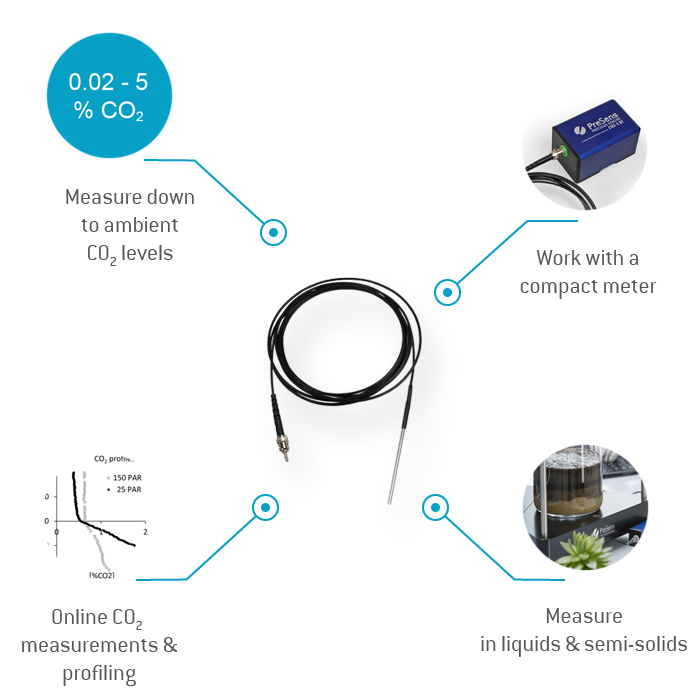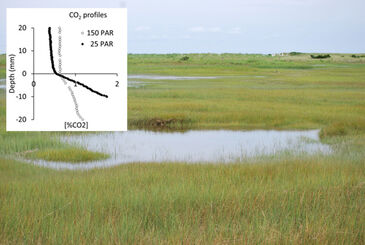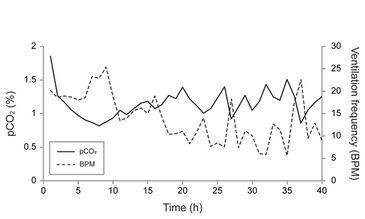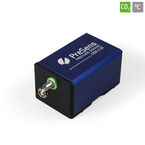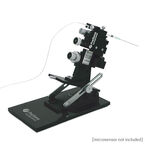Watch tutorials, webinars and informative videos about PreSens optical sensor systems.
CO2 Monitoring in Semi Solids and Liquids
Low Range CO2 Steel Dipping Probe DP-CDM1-ST
The carbon dioxide dipping probe type CDM1 is compatible with the multi-purpose carbon dioxide meter CO2-1 ST. It is designed for measuring down to ambient CO2 levels in a range of 0.02 % - 5 %. The fiber end with attached carbon dioxide sensor is covered by a robust stainless-steel fitting so the probe can be put into semi-solid samples as well as in liquids without a problem. The probe has an outer diameter of 3 mm and a standard length of 10 cm; other lengths are available on request. The probe can be combined with the PreSens Manual and Automated Micromanipulators. It is ideally suited for analyzing liquids or environmental and biological research.
- CO2 measurement in liquids & semi solids (0.02 % to 5 % CO2)
- Robust for custom applications
- For biological & environmental research
- Ideal for analyzing liquids
Applications
CO2 Monitoring at the Sediment-Water Interface
The PreSens CDM1 CO2 probes combined with PreSens Micromanipulators are ideally suited for profiling applications. Profiling in salt marsh ponds with our optical probes showed, that while oxygen levels are strongly affected by microbial photosynthetic activity, pH and CO2 at the sediment surface was unaffected by varying light conditions suggesting a high buffering capacity of the pond water and sediment.
(Application Note K. Koop-Jakobsen et al.)
CO2 Measurements in Plant & Animal Physiology
CO2 is an important parameter in respiration and metabolic processes. PreSens CDM1 CO2 probes are ideally suited for measurements in animal or plant research. Due to their small size, they can be integrated in many set-ups where CO2 electrodes would not fit. The graph on the left shows in vivo CO2 measurements in the haemolymph of a water-breathing dragonfly nymph.
(Application Note D. J. Lee et al.)
Monitoring CO2 in Fish Digestive Tracts
Needle-mounted PreSens fiber optic pCO2 microsensors proved to be ideal for measurements inside fish digestive tracts, as it was important to insert the sensor without rupturing the tract. The needle could be inserted through the wall of the tract directly into the desired location, allowing sequential monitoring of pCO2 in various sections of the gut. These measurements demonstrated that the pCO2 in the digestive tract is surprisingly high even in fasted fish, far above blood level, and is markedly elevated after feeding in teleosts.
(Application Note C. M. Wood et al.)
Technical
| Specifications */** | |
|---|---|
| Measurement range | 0.02 % - 5 % CO2 at atmospheric pressure |
| Response time (t90) for a CO2 change from 0.5 % to 1 % | < 5 min (at 25 °C) < 3 min (at 37 °C) |
| Resolution at 25 °C | ± 0.001 % at 0.1 % CO2 |
| Measurement temperature range | From 12 °C to 42 °C |
| Properties** | |
| Compatibility | Aqueous solutions, pH 4 - 9 Organic solvents, volatile acids (e.g. HCl vapours, acetic acid) and sulfidic environments damage the sensor irreversibly |
| Calibration | CO2 sensor are pre-calibrated; re-calibration is possible and recommended |
*preliminary data | |


